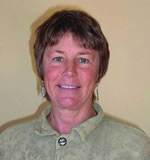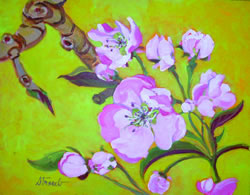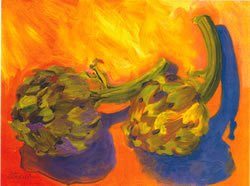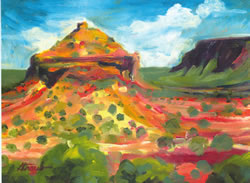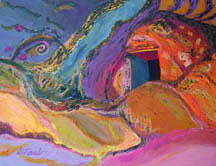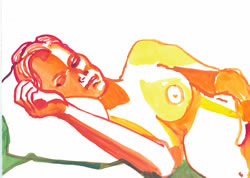Artist of the Month - January 2006 Straub’s
Strokes |
||||||
The comparison is there. It’s difficult to avoid. Watch. This month, I’m looking into the art of a woman who specializes in “plein air” (literally “outdoor”) painting, both landscapes and still lifes done on site. She is a handsome woman in her fifties who relocated to a small western community that is slowly becoming a vortex for other artists like her. The most recognizable of her paintings are enlarged views of flowers and plants, where the painter has boldly captured the feminine contours of the blooms and where color dominates over detail. No, I’m not talking about Georgia O’Keefe. This month we’re taking a closer look at the work of Moab’s artist, Robin Straub, whose paintings and persona evince the magic of the renowned painter who came before her.
Straub’s art is feminine without being sentimental. She interprets her view of the natural world around her in bold colors and brush strokes that replicate the contours of the female body. The comparison between O’Keefe and Straub is neither accidental nor sought after. Indeed, Straub is very familiar with her predecessor’s work and considers herself an admirer of O’Keefe’s work. She does not, however, strive to emulate her, but has in common a deep love of the desert and what can thrive there. This love affair with the desert is what brought her to Moab and what continually inspires her. A lover of nature and gardening, Straub generally paints in the outdoors. She camps, hikes and hauls her materials to sketch and paint on site, rather than waiting to return to the studio. She prefers to work from nature rather than photographs and is excited by this process. This desire to paint in the open
creates a sense of freshness and immediacy in her paintings
since she must work quickly before the scene changes. Most
notably, she must capture the essence of her subject before
the light source moves too far, creating different shadows
and colors.
Highly influenced by Fauvism, a
turn-of-the-century art movement led by Henri Matisse,
Straub uses bold, brilliant hues. Fauvism evolved from
Impressionism, creating a distinctive style by using pure
colors, sometimes straight from the paint tubes, and applying
it in swift, broad strokes to create a vibrant result.
The distinctive quality in her
representations of the area landscapes is the vivid palette
she uses, which is generally as she claims, “brighter
than the actual colors.” In “Cheesebox Butte,” for
instance, she allows streaks of crimson and purple to show
through rather than blending them in with softer colors
in order to tone them down. In her latest painting, “Granary,” she applied acrylics with a brush while painting outdoors and then later went over the acrylic with oils in her studio, using a palette knife instead of a brush. She is experimenting with this new technique in part because she likes the relief and texture of oils (which take longer to dry, making acrylics easier to use in plein air painting) and in part because she likes the spontaneity of the palette knife, over which she has much less control than a brush.
Despite the straight edge of the knife, she retains soft contours in her composition. This became clearly evident to me as I laid out two of her works side by side, one a quick figure study done of the top half of a reclining woman and the second, “Granary,” depicting a clearly defined doorway in a swirling mass of color resembling a canyon. The contours of the woman’s elbow, breast, shoulder and belly are all unconsciously replicated in the contours of the canyon landscape. These two paintings are not meant to be connected, but the similar feminine curves found in both help explain Straub’s feminine perspective in her paintings. The colors of the landscape in “Granary” are bold, but darker than in her previous works. The rectangular door composed of an indigo wall, a crimson ceiling and a black interior stands in stark contrast to the rolling contours of the surrounding rock, inviting the viewer’s perspective to linger on that entrance and wonder what lies within. Although the contours in the landscape are soft, the strokes created by the palette knife are sharp and angular, imbuing the painting with an edgier look than Straub’s still lifes and nudes.
The feminine quality to her paintings
produces more of a feeling of sensuality rather than sentimentality,
a similarity that once again harkens to the paintings of
O’Keefe. Straub’s painting of two yellow-green
artichokes casting purple shadows on an orange background
pulses with vitality, unusual for a still life. The saturated
hues of the four main colors lend a richness to the work.
The artichokes with their curved stems look as if they
have randomly rolled into position, one leaning against
the other, lending a feeling of spontaneity to the composition.
Like O’Keefe’s famous petals, the leaves on
these artichokes exude feminine sensuality. |
